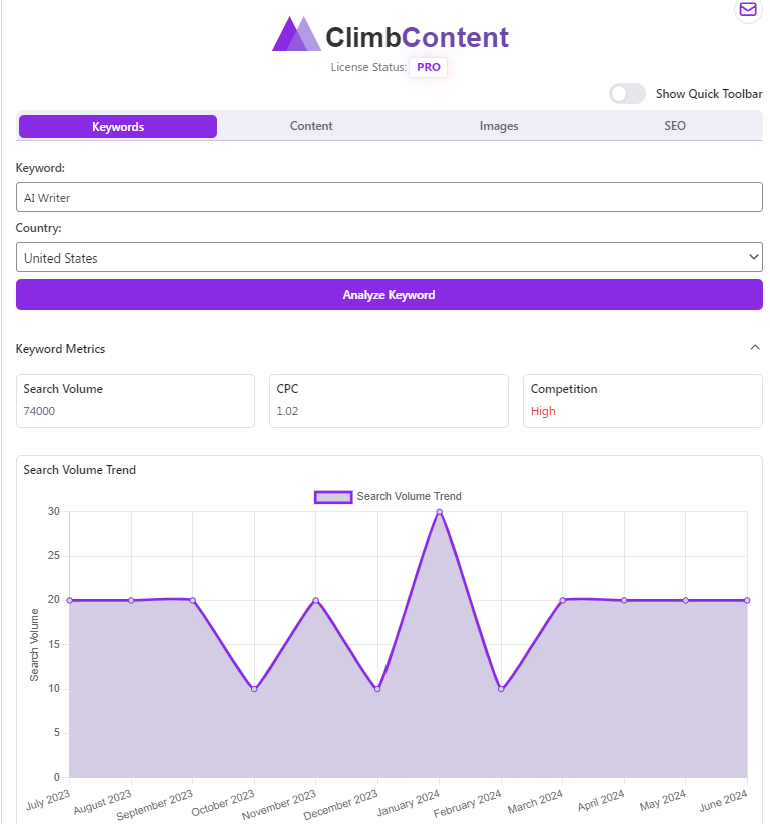Table of Contents
- Introduction
- How to Conduct Keyword Performance Analysis?
- How do you measure effectiveness of keywords?
- How do you identify high performing keywords?
- How do you Conduct Keyword Performance Analysis for SEO?
- keyword performance analysis with ClimbContent,com plugin.
- Summary
Introduction
Unlocking the secrets of effective keyword performance analysis just got simpler. With the power of AI Writer, you can dive deep into understanding keyword strategies and improve your SEO performance. Whether you’re using tools like Google Analytics, SEMrush, or the ClimbContent.com plugin, our guide will help you make data-driven decisions effortlessly.
How to Conduct Keyword Performance Analysis?
To analyze keyword effectiveness, start by gathering data from tools like Google Analytics or SEMrush. Focus on metrics such as search volume, competition, and click-through rates. Identify the most relevant keywords for your target audience. Break down the performance of these keywords in terms of traffic and conversions. Use spreadsheets to organize this data for easy comparison. Look for patterns and trends over time. Analyze the quality of the traffic generated by each keyword. Check if the keywords align with your business goals and audience’s intent. Finally, refine your SEO strategy based on these insights. Continuous monitoring and adjustment are essential.
How do you measure effectiveness of keywords?
Measuring the effectiveness of keywords involves several key metrics. One primary metric is search volume, representing how often people search for the keyword. Another metric is click-through rate (CTR), which shows how often people click on the keyword in search results. Conversion rate is also crucial; it tells you the percentage of visitors who take a desired action after clicking on the keyword. Use tools like Google Analytics and keyword planners to track these metrics. Finally, constantly monitor and adjust your keywords to maximize their performance. This ongoing evaluation ensures that your keywords remain relevant and effective.
How do you identify high performing keywords?
Identifying high-performing keywords involves several strategic steps. Start by using keyword research tools like Google Keyword Planner or SEMrush. These tools help you find keywords with high search volume and low competition. Analyze your competitors’ keywords to discover which ones bring them the most traffic. Long-tail keywords often yield better results as they are more specific. Examine metrics such as click-through rates (CTR) and conversion rates. Keep an eye on seasonal trends to adjust your keywords accordingly. Regularly updating and testing your keyword list is essential for optimization. Finally, align your keywords with user intent and your content strategy. This combined approach helps you identify high-performing keywords effectively.
How do you Conduct Keyword Performance Analysis for SEO?
To analyze SEO performance, start by checking your website’s search engine rankings for target keywords. Use tools like Google Analytics and Google Search Console to monitor organic traffic and user behavior. Evaluate keyword performance and identify which terms drive the most traffic and conversions. Review backlink profiles to ensure you have quality, relevant links. Perform regular site audits to find and fix technical issues, such as broken links and slow load times. Assess content effectiveness by measuring engagement metrics, including bounce rate and time on page. Finally, compare your performance against competitors to identify areas for improvement. Regularly update your analysis to stay aligned with evolving SEO trends.
keyword performance analysis with ClimbContent,com plugin.
Start with your keyword in the Keywords box and instantly get trend analysis on the keyword and other important metrics. This small utility quickly gives you an idea about the keyword. The plugin not only provides analytics but also sets the foundation for all the content you will write using the ClimbContent.com plugin. It pulls in all the questions people ask on Google about that keyword. This includes understanding what others are looking for. The insights are immediate and actionable. You can tailor your content to meet real user queries. This ensures your content is always relevant and targeted.

Summary
Enter keywords for immediate trend analysis and user queries. Tailor content based on insights for relevance and targeting.
